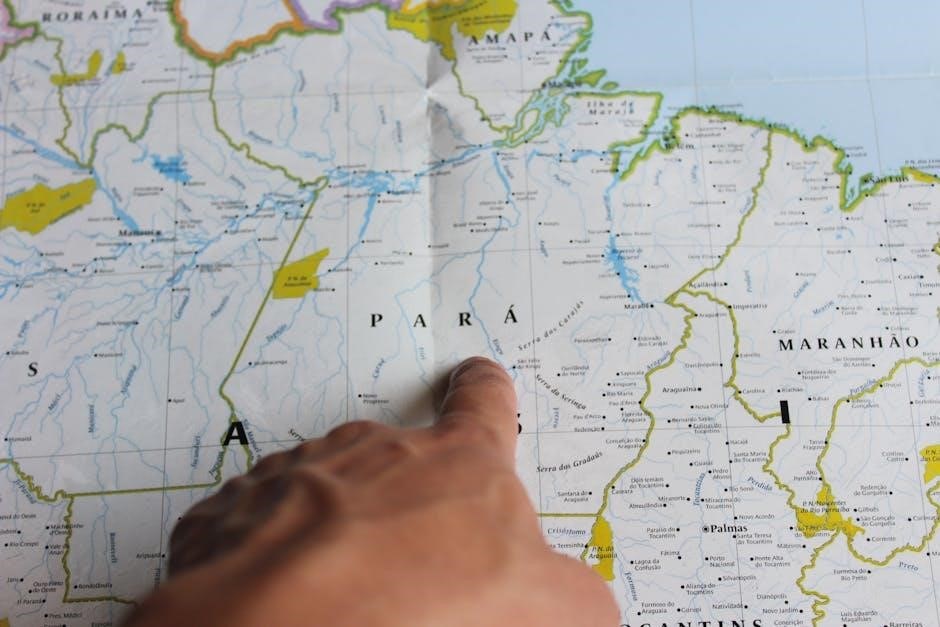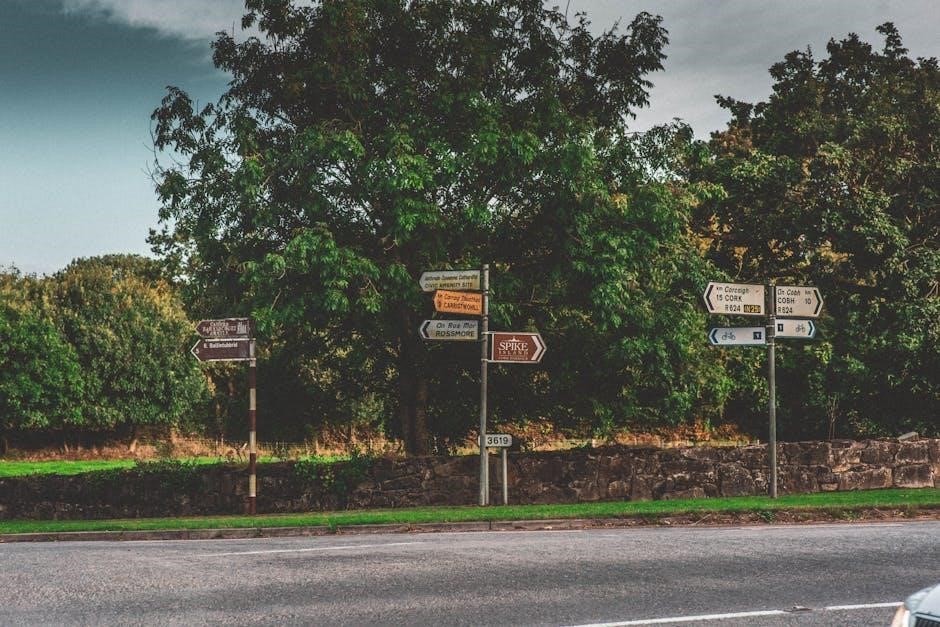
Zone 6B offers a moderate climate with warm summers and cold winters, making it ideal for growing a variety of plants․ Gardeners here enjoy a relatively long growing season, with average last frost dates in late spring and first frost dates in early fall․ This zone supports both cool-season and warm-season crops, providing ample opportunities for year-round gardening․ Understanding the unique conditions of Zone 6B is key to successful planting and maintaining a thriving garden․
Understanding USDA Hardiness Zones
The USDA Hardiness Zones are a guide to determine which plants can thrive in specific areas based on average annual extreme temperatures․ Zone 6B, with its moderate climate, has winter temperatures ranging from -5°F to 0°F (-20․6°C to -17․8°C)․ This system helps gardeners select plants suited to their region, ensuring better growth and survival․ Zone 6B’s relatively long growing season supports a wide variety of plants, from vegetables to ornamentals, making it a versatile zone for gardening enthusiasts․
Key Characteristics of Zone 6B
Zone 6B is characterized by its moderate climate, with warm summers and cold winters․ The average winter temperatures range from -5°F to 0°F, making it suitable for plants tolerant of light frost․ The growing season typically lasts 150-200 days, allowing for a diverse range of crops․ Soil types vary but often include well-drained, fertile options ideal for gardening․ Zone 6B supports both cool-season and warm-season plants, such as tomatoes and zinnias․ Proper watering and mulching are essential to maintain soil health and optimize plant growth in this versatile zone․
Preparing for Planting in Zone 6B
Preparing for planting in Zone 6B involves soil testing, understanding frost dates, and selecting suitable plants․ Proper timing ensures optimal growth and success in this moderate climate․
Soil Preparation and Testing
Soil preparation is crucial for successful gardening in Zone 6B․ Start by testing your soil to determine its pH level and nutrient content․ Most plants thrive in slightly acidic to neutral soil, with a pH between 6․0 and 7․0․ Add organic matter like compost or well-rotted manure to improve soil structure and fertility․ Test your soil in early spring or fall, using a DIY kit or professional service․ Proper soil preparation ensures optimal root development and nutrient uptake, giving your plants the best chance to flourish in Zone 6B’s climate․
Understanding Frost Dates
In Zone 6B, frost dates are critical for determining planting schedules․ The average last frost date in spring typically occurs in late April to early May, while the first frost date in fall is around late September to early October․ These dates mark the safe periods for planting tender seedlings outdoors․ Knowing your specific frost dates helps avoid damage to sensitive plants and ensures timely harvests․ Use this information to plan planting times, start seeds indoors before the last frost, and prepare for winter by protecting plants or harvesting before the first frost arrives․
Choosing the Right Plants for Zone 6B
Zone 6B’s moderate climate supports a wide variety of plants, including vegetables, flowers, and ornamentals․ Cool-season crops like broccoli and spinach thrive in spring and fall, while warm-season plants such as tomatoes and peppers excel in summer․ Select varieties with maturity dates that align with Zone 6B’s growing season․ Native plants and pollinator-friendly species are excellent choices for biodiversity․ Utilize planting charts and guides to ensure optimal selection for your specific zone, maximizing growth and yield throughout the year․

Planting Schedule for Zone 6B
Zone 6B’s moderate climate allows for a balanced planting schedule, supporting cool-season crops in spring and fall, and warm-season plants during summer’s heat․ Succession planting maximizes growth․
Vegetable Planting Calendar
Zone 6B gardeners can start seeds indoors 6-8 weeks before the last frost date, typically around late March․ Early spring crops like spinach and lettuce can be direct-sown in late March or early April․ Warm-season vegetables such as tomatoes and peppers should be transplanted after the last frost date, usually around early May․ Summer crops like corn and beans thrive in Zone 6B’s warm summers․ Fall gardens can include broccoli and kale, planted in late July or early August․ The growing season is long enough for most vegetables to mature before the first frost in early October․
Flower and Ornamental Planting Guide
Zone 6B offers ideal conditions for a wide variety of flowers and ornamentals․ Spring-blooming bulbs like tulips and daffodils should be planted in fall, around September or October․ Perennials such as coneflowers and daylilies thrive when planted in early spring or late summer․ Annuals like marigolds and petunias should be planted after the last frost date, typically in early May․ Consider planting cool-season flowers like pansies and violas in early spring or late summer for vibrant color during cooler months․ Proper timing ensures a stunning display of blooms throughout the growing season․
Monthly Gardening Tasks in Zone 6B
Zone 6B gardeners should plan tasks according to seasonal changes․ Spring focuses on soil prep and planting cool-season crops․ Summer involves watering, weeding, and monitoring for pests․ Fall includes harvesting, cleaning up beds, and planting bulbs for spring․ Winter requires protecting plants from extreme cold and planning for the next growing season․ Regular maintenance ensures a healthy and productive garden year-round․
Spring Planting and Care
In Zone 6B, spring planting begins after the last frost date, typically in late April or early May․ Start by testing and amending soil pH as needed for optimal growth․ Cool-season crops like broccoli, spinach, and lettuce can be planted as soon as the soil is workable․ Warm-season crops, such as tomatoes and peppers, should be started indoors 4-6 weeks before the last frost and transplanted outside after hardening off․ Mulch beds to retain moisture and suppress weeds, and water consistently to support healthy growth during this critical season․
Fall Planting and Preparation for Winter
Fall planting in Zone 6B begins 8 weeks before the first frost date, typically around late July․ Cool-season crops like kale, spinach, and Brussels sprouts thrive in cooler temperatures․ Plant them 6-8 weeks before the first frost for a successful harvest․ Use succession planting to extend the growing season, ensuring crops mature before winter․ Clean up the garden by removing spent plants and debris to prevent pests and diseases․ Add compost to enrich the soil for next year․ Mulch beds to protect soil health and retain moisture over winter․ Consider planting cover crops like clover to improve soil structure․ Plan ahead for spring by preparing beds and ordering seeds․ Proper preparation now ensures a healthy and productive garden come spring․

Garden Maintenance in Zone 6B
Regular weeding, pruning, and soil monitoring are essential․ Apply compost and mulch to retain moisture and suppress weeds․ Check for pests and diseases promptly to prevent spread․
Watering and Irrigation Tips
Water plants deeply but infrequently to encourage deep root growth․ Check soil moisture by inserting a finger into the soil up to the knuckle․ Water vegetables and flowers when the top 2-3 inches of soil feel dry․ Avoid overhead watering in the evening to reduce fungal diseases․ Use drip irrigation or soaker hoses for efficient watering․ Mulch around plants to retain soil moisture and reduce evaporation․ Adjust watering schedules during hot or rainy spells to prevent overwatering․
Mulching and Soil Conservation
Mulching and Soil Conservation
Mulching is essential for retaining soil moisture and regulating temperature in Zone 6B․ Apply a 2-3 inch layer of organic mulch like wood chips, straw, or bark around plants․ This helps suppress weeds and prevents soil erosion․ Replenish mulch annually as it breaks down, enriching the soil․ Avoid mulching too close to plant stems to prevent rot․ Mulching also reduces soil compaction and improves drainage, promoting healthy root growth․ It’s a simple yet effective practice for maintaining soil health and conserving water in your Zone 6B garden․

Common Challenges in Zone 6B Gardening
Zone 6B gardeners face challenges like unpredictable frost dates, soil erosion, and pests․ Managing these issues requires tailored strategies to protect plants and maintain soil health effectively․
Pests and Diseases in Zone 6B
Gardening in Zone 6B comes with challenges from pests like aphids, spider mites, and squash bugs, which can damage crops․ Diseases such as powdery mildew and root rot also threaten plants․ Regular monitoring, proper sanitation, and crop rotation are essential preventive measures․ Using neem oil and organic pesticides can help control infestations․ Ensuring good air circulation and avoiding overwatering reduces disease risks․ Early detection and treatment are critical to maintaining healthy plants and maximizing yields in Zone 6B gardens․
Dealing with Extreme Weather Conditions
Gardening in Zone 6B requires preparation for extreme weather like heatwaves, heavy rains, and early frosts․ Heatwaves can stress plants, so shading and consistent watering are crucial․ Heavy rainfall may lead to soil erosion, prompting the use of mulch and proper drainage․ Early frosts can damage sensitive plants, necessitating covers or bringing plants indoors․ Monitoring weather forecasts and implementing protective measures ensures plant resilience․ These strategies help gardeners in Zone 6B adapt to unpredictable conditions and safeguard their crops effectively throughout the growing season․

Tools and Resources for Zone 6B Gardeners
Essential tools include gloves, trowels, and watering cans․ Resources like the Kellogg Garden Zone Planting Charts provide detailed guides for optimal planting and harvesting schedules․
Essential Gardening Tools
Gardening in Zone 6B requires the right tools for success․ A sturdy shovel and trowel are must-haves for soil preparation․ Pruning shears help maintain plant health, while gloves protect hands․ A watering can or hose ensures proper hydration․ Soil testing kits are crucial for monitoring pH and nutrient levels․ Seed starting trays and grow lights support early-season planting indoors․ A garden fork aids in aerating soil, and a wheelbarrow simplifies transporting plants and mulch․ These tools make gardening efficient and enjoyable, helping you achieve a thriving garden in Zone 6B․
Recommended Planting Charts and Guides
For Zone 6B gardeners, using reliable planting charts and guides is essential for success․ The USDA Hardiness Zone Map and local frost date calendars are invaluable tools․ Specific planting charts, such as the Kellogg Garden Zone Planting Guide, provide detailed timelines for sowing seeds and transplanting plants․ These resources help gardeners align their efforts with the region’s climate, ensuring optimal growth․ Additionally, vegetable-specific guides offer insights into variety selection and spacing․ By following these charts, gardeners can maximize their harvest and enjoy a thriving garden tailored to Zone 6B’s unique conditions․
Gardening in Zone 6B offers a rewarding experience with its moderate climate and extended growing season․ By understanding frost dates, soil preparation, and plant selection, gardeners can thrive in this zone․ Utilizing planting charts and guides ensures timely sowing and harvesting․ Whether growing vegetables, flowers, or ornamentals, Zone 6B’s versatility accommodates diverse gardening goals․ Stay informed, adapt to local conditions, and enjoy the fruitful results of your efforts in this ideal gardening environment․